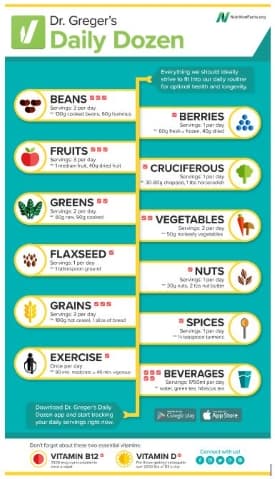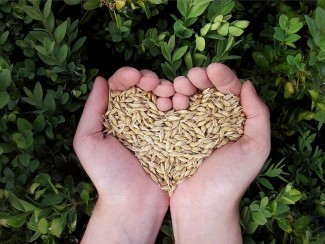
You’ve probably heard that you should eat lots of whole grains and we agree—but not all grains are in the same class. Read on to find out how many servings of grains you should be striving for in your daily diet, and just as importantly, which ones.
Experts don’t all see eye to eye on the exact quantity of whole grains, but most say your diet should include at least 3 and maybe as much as 11 servings, or about a quarter of your plate (if you imagine everything you eat in a day to be all on one plate and divided into the food groups). One source of guidance worth considering is NutritionFacts.org, a science-based nonprofit organization founded by Michael Greger, M.D. FACLM, that provides free updates on the latest in nutrition research via videos with captions, blogs, and infographics. NutritionFacts.org shares fact-based information on the benefits of a whole food, plant-based diet for wellness, disease prevention, healthy weight management, and longevity.
There is even a handy app called Dr. Greger’s Daily Dozen that allows you to simply check off the recommended foods for a healthy diet as you eat them each day—give the app a try and see if it can help you eat better!
What is a whole grain and which ones are the best?
A grain is a whole grain if all three original parts—the bran, germ, and endosperm—are still present in the same proportions as when the grain was growing in the fields. The bran, the multi-layered outer skin of the edible kernel, has antioxidants, B vitamins, and fiber. The germ, the embryo which has the potential to sprout into a new plant, holds many B vitamins, some protein, minerals, and healthy fats. The endosperm, the germ’s food supply, has starchy carbohydrates, proteins, and small amounts of vitamins and minerals.
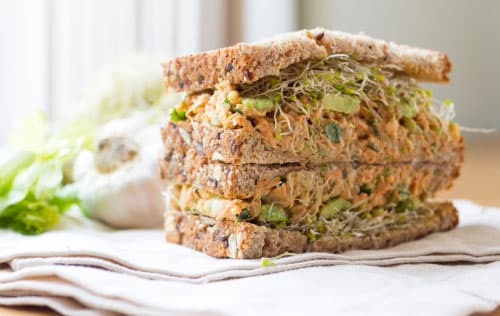
“Refined grain” is the term used to refer to grains that are not whole, because they are missing one or more of the three key parts (bran, germ, or endosperm). White flour and white rice are refined grains because both have had their bran and germ removed, leaving only the endosperm. These refined grains give baked goods a softer texture and an extended shelf life but make the product less nutritious. The bottom line is that these types of grains offer almost no health benefits to your body.
“Enriched grain” means that refined grains have been fortified with added nutrients. Although some of the vitamins lost in the refining process can be added back in, the lost fiber is not replaced.
The best choice by far is to simply eat whole grains which are high in many nutrients like fiber, magnesium, iron, B vitamins, phytonutrients, and more. Whole grains are also known for helping to prevent:
- Cardiovascular disease. Soluble fiber helps lower cholesterol. Fiber may also help prevent heart attacks and strokes.
- Type 2 diabetes. Essential minerals help reduce the risk of developing diabetes.
- Cancer. Phytoestrogens (plant estrogens) found in whole grains may protect against some cancers.
If that wasn’t enough to convince you, whole grains are also beneficial in supporting:
- Digestive health. Insoluble fiber helps move waste through the digestive tract faster and easier.
- Longevity. Whole-grain consumption has been linked in clinical studies with reduced risk of coronary heart disease, cardiovascular disease, and total cancer, and mortality from all causes.
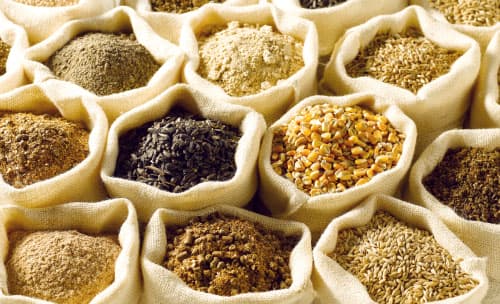
Figuring out which whole grains are best can be confusing—not all nutritionists agree. See the list below with some of our faves and learn which ones are great for your health and are ʻono, too! Keep trying whole grains from this list until you find the ones that you love to eat and serve to your ohana.
Barley
Barley has a higher amount of dietary fiber than any of the other grains, in addition to phytochemicals and the soluble fiber beta-glucan. The antioxidants in barley may help to reduce bad cholesterol and build immunity. It's also high in manganese, selenium, and thiamine (a B vitamin). Try this recipe - Herbed Barley Pilaf
Quinoa
Quinoa is a seed, but it can be used in place of grains in your diet. It's a source of complete vegetable protein because it has all essential amino acids. Quinoa also has fewer carbohydrates and more protein than many other grains, and it is high in magnesium, phosphorus, manganese, and folic acid. Try this recipe - Curried Quinoa
Amaranth
Amaranth is a small-sized, gluten-free whole grain with a good amount of protein—14 percent to 15 percent—higher than both buckwheat and rye. It has phytochemicals and is high in magnesium, manganese, and phosphorous. Try this recipe - Popped Amaranth Bars
Buckwheat
Buckwheat has antioxidants that can help prevent cancer and heart disease. Buckwheat is also high in soluble fiber, plus it’s high in magnesium, copper, and manganese. Try this recipe - Buckwheat Gnocchi
Teff
Teff is the tiniest grain, but it’s also one of the highest in protein. It's gluten-free, and an excellent source of iron and magnesium. Teff is also an excellent source of fiber, phosphorus, zinc, thiamin, and vitamin B6, and can supply over 100 percent of the recommended daily intake of manganese. Try this recipe - Ethiopian Injera Bread
Oats
Oats have polyphenols, which act as antioxidants and are a powerful anti-inflammatory agent. They are also high in beta-glucan, a type of soluble fiber that helps lower LDL (bad) cholesterol and may reduce the risk of some types of cancers. Oats also may help lower blood pressure and are a good source of fiber, iron, magnesium, phosphorus, zinc, copper, thiamin, manganese, and selenium. Try this recipe - Overnight Autumn Oats
Millet
Millet is high in antioxidants and manganese, and is also a good source of magnesium, phosphorus, copper, thiamin, and niacin. Try this recipe- Millet Fried Rice
When reading labels on breads, pastas, cereals, and other grain products to check to see if they are “whole grains” (and not “refined” or “enriched”), don’t forget the importance of choosing certified organic products, too. Scientific studies have shown that organic grains have a higher nutritional content than their conventional counterparts. Breads made with organic grains have also been proven to be more nutrient dense with fewer additives.
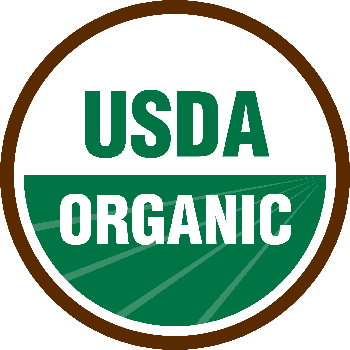
Organic products reduce health risks to farm workers, their families, and all of us by minimizing the exposure to toxic and persistent chemicals on the farm, in food, in the soil, in the air we breathe, and in the water we drink.
We hope this grains info can help you to shift to a better and more nutritious diet. Eating healthy foods and feeling your best are undoubtedly worth the effort. We’re sure that the products and friendly teams at our Down to Earth stores can help you on your journey to your best quality of life—stop by and visit us!
